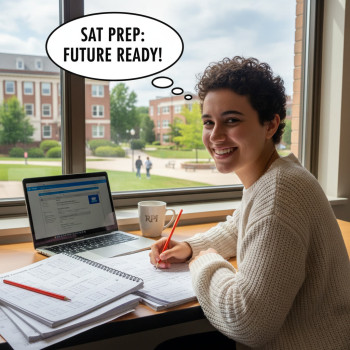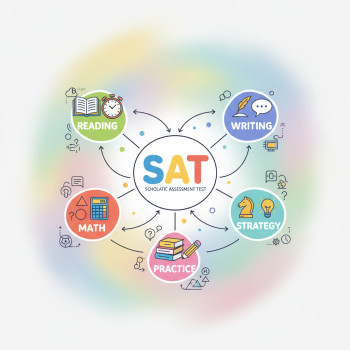Introduction: Why SAT Score and Activities Together Tell a Story
There’s a quiet myth floating around the college-admissions world that a single number—your SAT score—will open or close doors. It’s not true. Admissions officers read applications as narratives: grades, test scores, essays, recommendations, and extracurriculars all combine into a portrait of who you are, how you spend your time, and what you might bring to a campus. The Digital SAT matters because it communicates academic readiness, but what you do outside class reveals passion, resilience, leadership, and curiosity. Together, they form a complete profile.

Start with a Plan: Timeline and Goals
Think of your college profile like a garden. You plant seeds early (freshman and sophomore years), tend them (junior year), and harvest in applications (senior year). A clear timeline keeps you from scrambling at the last minute.
Sample Year-by-Year Roadmap
| Year | Focus | Key Actions |
|---|---|---|
| Freshman | Explore & join | Try clubs, volunteer, take challenging classes, start light test prep (vocabulary, reading habits) |
| Sophomore | Commit & build | Take leadership roles, begin deeper SAT practice, meet a tutor if needed, start a long-term project |
| Junior | Improve & demonstrate | Take PSAT/NMSQT, competitive activities, solid SAT prep (aim for full-length digital practice tests), hone essays |
| Senior | Polish & present | Finalize SAT if needed, finish major projects, get recommendations, submit applications |
This timeline gives space to grow: colleges value sustained commitment more than a flurry of last-minute involvement. That means depth beats breadth in most cases—three or four meaningful activities over several years often tell a stronger story than a long list of one-off events.
Understanding the Digital SAT—What Admissions See
The SAT changed in recent years to a digital format. The exam still measures reading, writing, and math skills—but test day looks different: adaptive sections, built-in tools (like a calculator for Math), and shorter, more focused modules. Colleges recognize the Digital SAT as a measure of academic readiness in a modern testing environment.
How to Use Your Digital SAT Strategically
- Set a realistic target score based on the colleges you like—but also aim to beat your personal baseline.
- Use practice tests that mirror the digital experience to learn pacing and digital interface comfort.
- Compare score ranges of admitted students at your target colleges as one data point—don’t treat them as absolutes.
Remember: test scores are one element of the application. A strong score helps, but it’s the combination of scores and authentic extracurriculars that often seals the deal.
Extracurriculars: Quality, Consistency, and Impact
Extracurricular activities are where students show values, interests, and initiative. Admissions officers want to see what you care about and how you follow through. Here’s how to think about extracurriculars strategically.
Three Ways Activities Add Value
- Depth: Long-term involvement shows dedication. For example, being on the school newspaper for four years with eventual editor responsibility speaks volumes.
- Leadership: Leading a team, club, or community initiative demonstrates responsibility and influence.
- Impact: Concrete outcomes—raising funds, organizing events, launching a program—show you produce results.
Try to select activities that align with your academic interests or career goals. If you love biology, volunteering at a local clinic or starting a health-awareness campaign uses your passion in meaningful ways. If you’re drawn to coding, building a small app or contributing to open-source projects gives you tangible artifacts to show.

Creating a Cohesive Narrative: Connect SAT, Classes, and Activities
Your application should read like a story with themes. Admissions committees often prefer coherence—how your academic choices, test prep, and extracurriculars reinforce one another.
Examples of Strong Narrative Threads
- STEM-Focused: Rigorous math/science classes, high Digital SAT Math score, robotics club leadership, summer research internship.
- Service-Oriented: Volunteer work over several years, coursework in social sciences, strong writing score on the Digital SAT, an essay about community impact.
- Creative Path: Portfolio of artistic work, AP/IB art classes, arts leadership roles, balanced SAT scores demonstrating academic readiness.
A coherent narrative doesn’t mean you must be one-dimensional. It means your activities and achievements should reinforce key strengths you want admissions officers to remember.
Practical Steps to Strengthen Both Sides
Below are immediate, practical steps to boost both SAT readiness and extracurricular impact.
For the Digital SAT
- Take a diagnostic digital practice test to set a baseline.
- Create a study plan with weekly goals (content review, timed sections, error logs).
- Do full-length practice tests under test-like conditions at least once every 2–3 weeks in the months before your target test date.
- Analyze missed questions by type and difficulty; focus on patterns rather than random mistakes.
- Use official digital practice tools and College Board resources for familiarization.
For Extracurriculars
- Pick 3–5 main activities to prioritize—one or two signature activities and a couple of supporting ones.
- Document your role, dates, hours, and measurable outcomes—this makes it easier to write application descriptions.
- Take initiative: propose a new role, start a sustained project, or create a measurable improvement in an existing program.
- Seek mentors—teachers, coaches, community leaders—who can provide specific, supportive recommendation letters.
How to Balance Time: Realistic Weekly Schedules
Balancing classwork, SAT prep, and activities is a common stressor. The key is consistent, sustainable effort rather than heroic last-minute bursts.
Sample Weekly Schedule (Junior Year, Busy Month)
| Day | Academic / Test Prep | Extracurricular | Rest / Family |
|---|---|---|---|
| Monday | 60 min SAT practice (Math focus) | 1.5 hr Robotics club | Evening relaxation |
| Tuesday | 45 min reading comprehension drills | Volunteer shift (2 hr) | Family dinner |
| Wednesday | 90 min content review (writing and grammar) | Leadership meeting (1 hr) | Short walk / downtime |
| Thursday | Practice with digital tools (30 min) | Creative project work (2 hr) | Movie night |
| Friday | Timed section practice (60 min) | Club social event | Rest |
| Saturday | Full-length practice test (3 hr) | Project implementation | Family time |
| Sunday | Review test mistakes (60–90 min) | Prep for upcoming week | Relaxation |
Adjust this to fit your workload. Some weeks require more academic focus; others need more attention on activities because of events or competitions. The goal is predictability rather than perfection.
Crafting Application Materials That Reflect Both Strengths
When it comes to applications, you want to present SAT scores, coursework, and extracurriculars in a way that reinforces your narrative.
Resume and Activity Descriptions
- Be concise: Use bullet-style descriptions with clear verbs (organized, founded, led, increased, raised).
- Quantify impact: numbers catch attention—hours served, money raised, percentage improvements.
- Prioritize: lead with your most meaningful activities in the application form and resume.
Essays and Supplemental Responses
Essays are where you connect the dots. Use specific anecdotes to show growth: a challenge you faced in a club, how a particular SAT setback taught you better study habits, or how a project revealed a career interest. Make the SAT part of the story when it fits: perhaps the digital practice taught you resilience, or a tutoring experience inspired a volunteer initiative.
Letters of Recommendation: Help Recommenders Tell Your Story
Recommenders can’t repeat your whole life, but they can highlight key strengths that confirm your narrative. Give recommenders prompts and context—remind them of projects, memorable moments, and the themes you want emphasized (leadership, curiosity, community service).
What to Provide to a Recommender
- A one-page summary of your activities and achievements.
- Specific examples you’d like them to mention (e.g., leading a community fundraiser that raised $2,500).
- Your target schools and the program of study, so they can tailor the letter.
Use Tools Wisely: BigFuture and Opt-In Services
College planning platforms can help you refine your list, find scholarships, and connect with colleges. Services that allow colleges to find you can be useful, especially if you’re open to schools you haven’t considered yet. Opting into these services is a strategic choice—update profiles and interests so outreach you receive is relevant.
When and How to Use Tutoring: Personalized Help That Fits
Not all students need the same help. Some need a math boost; others practice timing and test strategy. Personalized tutoring can accelerate progress by focusing on weak spots and creating accountability.
What Good Tutoring Offers
- 1-on-1 guidance tailored to your baseline and goals.
- Targeted study plans that fit your schedule and focus on areas with the most score gain potential.
- Expert tutors who can model problem-solving approaches and coach admissions narratives when appropriate.
- Adaptive, data-driven insights—helping you know what to prioritize next.
If you’re considering tutoring, look for programs that combine subject mastery with admissions insight. For many students, Sparkl’s personalized tutoring—offering one-on-one guidance, tailored study plans, expert tutors, and AI-driven insights—fits naturally into a balanced approach. It can be particularly helpful when you want focused score improvement while maintaining commitments to your activities.
Putting It All Together: Sample Student Profiles
Here are three composite examples showing how scores and activities can form cohesive profiles.
Profile A — The Aspiring Engineer
- Academic: Rigorous math and physics classes; Digital SAT Math score above the school’s median.
- Activities: Robotics team (co-captain), summer research internship at a university lab, volunteer STEM tutor in middle school.
- Narrative: Demonstrates love of problem solving, leadership in team environments, and a commitment to mentorship.
Profile B — The Community-Focused Leader
- Academic: Strong coursework in social sciences and writing; balanced SAT scores with higher Evidence-Based Reading & Writing.
- Activities: Founded a local food drive, long-term volunteer at a community center, student government treasurer.
- Narrative: Clear focus on community impact, organizational skills, and an ability to translate ideas into action.
Profile C — The Creative Scholar
- Academic: Advanced arts classes and AP Literature; solid Digital SAT scores that confirm academic readiness.
- Activities: Curated a student art exhibition, published writing in a youth magazine, part-time design freelance work.
- Narrative: Blend of artistic practice and academic achievement that suggests readiness for interdisciplinary study.
Common Mistakes and How to Avoid Them
Avoid these pitfalls when building your profile:
- Chasing activities without interest: Don’t join something just because it “looks good.” Authenticity matters.
- Overloading: Too many superficial commitments can dilute your story. Focus on impact.
- Last-minute test cramming: Consistent practice beats frantic, last-minute efforts for the Digital SAT.
- Ignoring fit: A high score doesn’t guarantee fit—research programs and campus cultures you genuinely want to join.
How Parents Can Support Without Taking Over
Parents play a huge role in college readiness—logistically, emotionally, and financially. The best support is steady, not controlling.
Actionable Ways Parents Can Help
- Create routines that protect study and rest time.
- Help with scheduling (practice tests, deadlines) but let students take ownership.
- Encourage exploration—allow downtime for creative pursuits or a new club.
- Help gather documentation for recommendations and applications (transcripts, activity logs).
Measuring Progress: When You’ve Built a Strong Profile
How do you know you’re on the right track? Look for these signs:
- Consistent improvement on Digital SAT practice tests and in the classroom.
- Increased responsibility and measurable outcomes in your activities.
- Strong, specific recommendation letters that reference concrete incidents.
- Confidence in essays that make a cohesive case for your interests and goals.
Final Checklist Before You Apply
- Have you taken realistic, timed digital practice tests and analyzed your mistakes?
- Do you have 3–5 activities that you can describe with depth, hours, and impact?
- Have you updated your BigFuture or college planning profiles and considered opt-in services if appropriate?
- Have you prepared recommenders with a clear packet about your achievements and goals?
- Is your application narrative consistent across essays, activities, and test score framing?
Parting Thought: Your Profile Is More Than the Sum of Parts
College applications can feel like a checklist, but they’re really an opportunity to show a human story—who you are and how you’ve grown. The Digital SAT is an important data point, but your extracurriculars show what you care about and how you act on those cares. Start early, choose depth over noise, be intentional about narrative, and seek help where it accelerates growth.
If you’d like a tailored plan—both for SAT improvement and for sculpting a meaningful activity portfolio—consider reaching out for personalized guidance. A program that combines one-on-one tutoring, a tailored study plan, expert tutors, and AI-driven insights can help you prioritize the highest-impact steps and free up time to do what you love.
Take a deep breath. Build steadily. Tell your story honestly. Admissions readers want to meet the real you—test scores and activities together are how you invite them in.














No Comments
Leave a comment Cancel